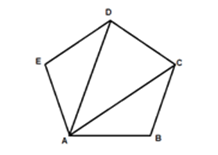6th Grade > Biology
GETTING TO KNOW PLANTS MCQs
:
A complete flower is one that contains all the reproductive (stamens and pistil) and non-reproductive (petals and sepals) parts.
:
1 Mark each
[Mention any three]
1. In some plants, the underground stem is modified to store food in the form of starch. Three types of underground stem modifications are tubers (e.g. Potato), rhizome (e.g.Ginger) and bulb (e.g.Onion).
2. In some desert plants, leaves are absent or reduced to spines. Here, the stem is green and performs photosynthesis to synthesise food.
3. In some plants like rose, stems are modified into thorns to protect the plant from being eaten by animals.
4. In climbing plants, stems are modified sometimes into structures which twine around the support.
5. In some plants like cactus and jade, stems become fleshy and succulent to store water.
:
Definition: 1 Mark each
Creepers are plants with weak stems. They cannot stand upright and spread on the ground.
Climbers are plants with weak stems which take support on neighbouring structures to grow.
:
1 Mark each
Leaves are arranged in different patterns at the node on the stem. The arrangement can be alternate, opposite and whorled.
1. In an alternate leaf arrangement, there is one leaf per node and they alternate sides.
2. In an opposite arrangement, two leaves arise from the same node on opposite sides of the stem.
3. In a whorled arrangement, there are at least three leaves at each node of the stem.
:
The labeled part in the image is the leaf blade or lamina.
Lamina is the broad, green part of the leaf that is exposed to sunlight.
:
Definition: 1 Mark
Example: 1 Mark
Fibrous roots are a group of lateral roots arising from the base of the stem. In plants bearing fibrous roots, the initial tap root slowly weakens and is replaced by a bunch of roots arising from the base of the stem. These bunch of roots forms the fibrous roots.
Examples of plants with fibrous roots are banana, grass and onion.
:
Definition : 1 Mark
Each Modification : 1 Mark
In some plants, leaves get modified to perform some special functions other than the normal ones, such as photosynthesis and transpiration. Sometimes these modifications are in response to certain environmental conditions. This type of alteration of leaves is called leaf modification.
Some leaf modifications are as follows:
1. In weak-stemmed plants, leaves are modified into special structures which twine around a support. These are tendrils. These offer support to the plant while climbing up.
2. In some plants like onion, leaves are modified to store food. These are termed to be scaly leaves.
3. In some desert plants like cactus, leaves are reduced to spines so as to reduce the loss of water through transpiration. These spines are also called as thorns. Thorns protect these plants from grazing animals.
4. In some insectivorous plants, leaves are modified into pitchers where they are used to trap insects. These insects can be digested inside the body of the plant. In this way, plants obtain nitrogen from animals.
:
1 Mark each
1. Rhizome
It is fleshy, non-green underground stem. It has distinct nodes and internodes. Adventitious roots arise from the lower side. Examples - ginger, turmeric, banana
2. Bulb
It is a highly condensed discoid stem. Its upper surface a terminal bud and many fleshy leaves are present. A cluster of adventitious roots arises from the base of the bulb. Examples - onions, lily
3. Tuber
Stem tuber is a swollen tip of an underground lateral Stem. It is covered by a rough skin with a number small nodes called eyes. Examples - potato, cassava
4. Runner
It is a creeping stem with long internodes, running horizontally on the soil surface. The nodes bear axillary buds, scale leaves, and adventitious roots. Examples - grasses, strawberries.
5. Stem tendrils
Stem or its branches get modified into a green thread-like leafless structures called tendrils which are meant for climbing. These may be branched or unbranched. Examples - grapevines
:
1 Mark each
The pistil is the female reproductive part of a flower. It is made up of the stigma, the style and the ovary.
1. The stigma is a bulged sticky structure at the tip of the pistil. As it is sticky it receives pollen grains from the male reproductive structure.
2. The style is a long tube-like structure which allows pollen grain to travel from the stigma to the ovule which bears the egg cell.
3. Ovary is a large lobed structure at the base of the pistil. It contains ovules which bear the female reproductive cells.
:
Classification based on presence of flowers: 2 Marks
Classification based on mode of nutrition: 3 Marks
Depending on the presence of flowers, plants are classified into two types namely, flowering plants and non-flowering plants.
1. Flowering plants are the plants which possess flowers and reproduce through seeds. E.g. mango, papaya, guava, etc.
2. Non-flowering plants are the plants which do not use flowers to reproduce. These plants reproduce through spores. E.g. ferns, mosses, etc.
Depending on the mode of nutrition, plants are classified into autotrophic and heterotrophic.
1. Autotrophic plants are the plants which make their own food by the process of photosynthesis by using raw materials like carbon dioxide and water. All green plants exhibit photosynthesis.
2. Heterotrophic plants are the plants which depend on other organisms for their food.
For example, plants like venus flytrap that derive their nourishment from insects are called insectivorous plants.

















